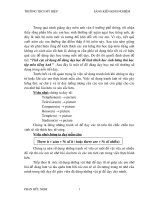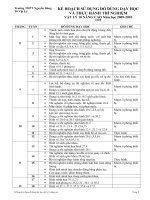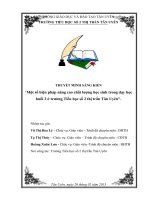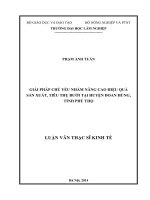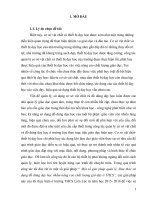Nâng cao DDDH buổi 8
Bạn đang xem bản rút gọn của tài liệu. Xem và tải ngay bản đầy đủ của tài liệu tại đây (338.45 KB, 4 trang )
PRO 3M/3MPLUS – ƠN LUYỆN TỒN DIỆN CHO KÌ THI TỐT NGHIỆP THPT QUỐC GIA
Biên soạn: Cô Vũ Thị Mai Phương – Ngoaingu24h.vn
TÀI LIỆU ĐI KÈM LIVESTREAM
LUYỆN ĐỌC ĐIỀN - ĐỌC HIỂU ( BUỔI 18)
Theo dõi LIVESTREAM ĐỘC QUYỀN của cơ vào lúc
20h30 ngày 16/1/2021 duy nhất trên khóa học PRO 3MPLUS
Cơ Vũ Thị Mai Phương
Trích đề thi học kì 1 lớp 12 năm học 2020- 2021- Sở giáo dục và đào tạo Thái Bình
Read the following passage and mark the letter A, B, C or D on your answer sheet to indicate the correct
answer to each of the question from 1 to 7.
EDUCATION IN THE FUTURE
Education is another area of social life in which information technology is changing the way we
communicate. Today's college students may not simple sit in a lecture or a library to learn about their
field. Through their computers and the wonders of virtual reality they can participate in lifelike stimulated
experiences. Consider the following scenario of the future of education made possible through
developments in information technology.
For children over the age of 10, daily attendance at schools is not compulsory. Some of the older
children attend school only once or twice a week to get tutorial support or instruction from a teacher. For
the most part, pupils are encouraged to work online from home. Students should complete a minimum
number of study hour per year; however, they may make up these hours by studying at home at times that
suit their family schedule. They can log on early or late in the day and even join live classes in other
countries. In order to ensure that each student is learning adequately, computer software will automatically
monitor the number hours a week each student studies online as well as student's learning materials and
assessment activities. Reports will be available for parents and teachers. The software can then identify
the best learning activities and conditions for each individual student and generate similar activities. It
can be also identify areas of weak achievement and produce special programs adjusted to the students'
needs.
(Source: n/technology-pros-cons/)
Question 1: What CAN’T the software do?
A. Identify weaknesses of the students.
B. Find out the best activities for the students.
C. Monitor the time the students learn.
D. Design materials for the students.
Question 2: The word “they” in the paragraph 2 refers to________.
A. students
B. study hours
C. schools
D. older children
Question 3: How many times are children who are older than 10 required to go to school weekly?
A. Three
B. No time
C. Once or twice
D. Four
Question 4: Which of the following could best replace the word “encouraged”?
A. stimulated
B. banned
C. allowed
D. discouraged
Question 5: What is NOT mentioned as a benefit of information technology to the student?
A. Students’ learning time won’t be monitored.
B. Students can learn at times that suit their schedule.
C. Students’ weak achievement can be identified
D. Students can stay at home to learn.
KHÓA HỌC PRO3M/PRO3MPLUS – CHINH PHỤC ĐIỂM 9+ MÔN TIẾNG ANH CÙNG CÔ VŨ MAI PHƯƠNG
PRO 3M/3MPLUS – ƠN LUYỆN TỒN DIỆN CHO KÌ THI TỐT NGHIỆP THPT QUỐC GIA
Biên soạn: Cô Vũ Thị Mai Phương – Ngoaingu24h.vn
Question 6: What is the topic of the passage?
A. Students don’t have to go to school any more.
B. Computer software will make sure students learn at home.
C. Students can know about their weak aspects to focus.
D. The effect of information technology on education.
Question 7: Who/What counts the number of hours per week that students spend learning?
A. Virtual reality
B. Computer software
C. Parents
D. Teacher
Trích đề thi thử lần 1 trường THPT Chuyên Lào Cai năm 2021
Read the following passage and mark the letter A, B, C or D on you answer sheet to indicate the
correct answer to each of the questions.
Stars have been significant features in the design of many United States coins and their number has
varied from one to forty-eight stars. Most of the coins issued from about 1799 to the early years of the
twentieth century bore thirteen stars representing the thirteen original colonies.
Curiously enough, the first American silver coins, issued in 1794, had fifteen stars because by that time
Vermont and Kentucky has joined the Union. At that time it was apparently the intention of mint officials
to add a star for each new state. Following the admission of Tennessee in 1796, for example, some
varieties of half dimes, dimes, and halfdollars were produced with sixteen stars.
As more states were admitted to the Union, however, it quickly became apparent that this scheme would
not prove practical and the coins from A798 on were issued with only thirteen Stars-one for each of the
original colonies. Due to an error at the mint, one variety of the A828 half cent was issued with only
twelve stars. There is also a variety of the large cent with only A2 stars, but this is the result of a die break
and is not a true error.
Question 8. What is the main topic of the passage?
A. Stars on American coins
B. The teaching of astronomy in state universities
C. Colonial stamps and coins
D. The star as national symbol of the United States
Question 9. The expression "Curiously enough" is used because the author finds it strange that
_________.
A. Tennessee was the first state to use half dimes
B. Vermont and Kentucky joined the Union in 1794
C. Silver coins with fifteen stars appeared before coins with thirteen
D. No silver coins were issued until 1794
Question 10. Why was a coin produced in 1828 with only twelve stars?
A. Tennessee had left the Union.
B. The mint made a mistake.
C. There were twelve states at the time. D. There is a change in design policy.
Question 11. Which of the following is NOT mentioned as the denomination of an American coin?
A. Half nickel
B. Half-dollar
C. Hall cent
D. Half dime
Question 12. The word "their" in line refers to _________.
A. features
B. Coins
C. stars
D. colonies
KHÓA HỌC PRO3M/PRO3MPLUS – CHINH PHỤC ĐIỂM 9+ MÔN TIẾNG ANH CÙNG CÔ VŨ MAI PHƯƠNG
PRO 3M/3MPLUS – ƠN LUYỆN TỒN DIỆN CHO KÌ THI TỐT NGHIỆP THPT QUỐC GIA
Biên soạn: Cô Vũ Thị Mai Phương – Ngoaingu24h.vn
Trích đề thi thử lần 1 trường THPT Chuyên Lào Cai năm 2021
Read the following passage and mark the letter A, B, C, or D on your answer sheet to indicate the
correct answer to each of the questions.
In the last third of the nineteenth century a new housing form was quietly being developed. In 1869 the
Stuyvesant, considered New York’s first apartment house was built on East Eighteenth Street. The
building was financed by the developer Rutherfurd Stuyvesant and designed by Richard Morris Hunt, the
first American architect to graduate from the Ecole des Beaux Arts in Paris. Each man had lived in Paris,
and each understood the economics and social potential of this Parisian housing form. But the Stuyvesant
was at best a limited success. In spite of Hunts inviting faỗade, the living space was awkwardly arranged.
Those who could afford them were quite content to remain in the more sumptuous, single-family homes,
leaving the Stuyvesant to young married couples and bachelors.
The fundamental problem with the Stuyvesant and the other early apartment buildings that quickly
followed, in the 1870’s and early 1880’s was that they were confined to the typical New York building
lot. That lot was a rectangular area 25 feet wide by 100 feet deep – a shape perfectly suited for a row
house. The lot could also accommodate a rectangular tenement, though it could not yield the square, welllighted, and logically arranged rooms that great apartment buildings require. But even with the awkward
interior configurations of the early apartment buildings, the idea caught on. It met the needs of a large and
growing population that wanted something better than tenements but could not afford or did not want row
houses. So while the city’s newly emerging social leadership commissioned their mansions, apartment
houses and hotels began to sprout in multiple lots, thus breaking the initial space constraints. In the closing
decades of the nineteenth century, large apartment houses began dotting the developed portions of New
York City, and by the opening decades of the twentieth century, spacious buildings, such as the Dakota
and the Ansonia finally transcended the tight confinement of row house building lots. From there it was
only a small step to building luxury apartment houses on the newly created Park Avenue, right next to the
fashionable Fifth Avenue shopping area.
Question 13. The new housing form discussed in the passage refers to _________.
A. row houses
B. hotels
C. apartment buildings
D. single-family homes
Question 14. It can be inferred that a New York apartment building in the 1870's and 1880's had all of
the following characteristics EXCEPT _________.
A. It was spacious inside
B. It had limited light
C. Its room arrangement was not logical D. It was rectangular
Question 15. The author mentions the Dakota and the Ansonia in paragraph 3 because _________.
A. they are examples of large, well-designed apartment buildings
B. they are famous hotels
C. they were built on a single building lot
D. their design is similar to that of row houses
Question 16. Why did the idea of living in an apartment become popular in the late 1880's?
A. The city officials of New York wanted housing that was centrally located
B. Large families needed housing with sufficient space
C. The shape of early apartments could accommodate a variety of interior designs
D. Apartments were preferable to tenements and cheaper than row houses
Question 17. The word "sumptuous" in paragraph 1 is closest in meaning to _________.
A. modern
B. unique
C. luxurious
D. distant
KHÓA HỌC PRO3M/PRO3MPLUS – CHINH PHỤC ĐIỂM 9+ MÔN TIẾNG ANH CÙNG CÔ VŨ MAI PHƯƠNG
PRO 3M/3MPLUS – ƠN LUYỆN TỒN DIỆN CHO KÌ THI TỐT NGHIỆP THPT QUỐC GIA
Biên soạn: Cô Vũ Thị Mai Phương – Ngoaingu24h.vn
Question 18. The word "they" in the passage refers to _________.
A. the Stuyvesant
B. fundamental problems
C. modern apartment buildings
D. early apartment buildings
Question 19. Why was the Stuyvesant a limited success?
A. Most people could not afford to live there
B. There were no shopping areas nearby
C. The arrangement of the rooms way not convenient
D. It was in a crowded neighborhood
Question 20. It can be inferred that the majority of people who lived in New York’s first apartments
were _________.
A. disadvantaged
B. highly educated C. young
D. unemployed
KHÓA HỌC PRO3M/PRO3MPLUS – CHINH PHỤC ĐIỂM 9+ MÔN TIẾNG ANH CÙNG CÔ VŨ MAI PHƯƠNG
